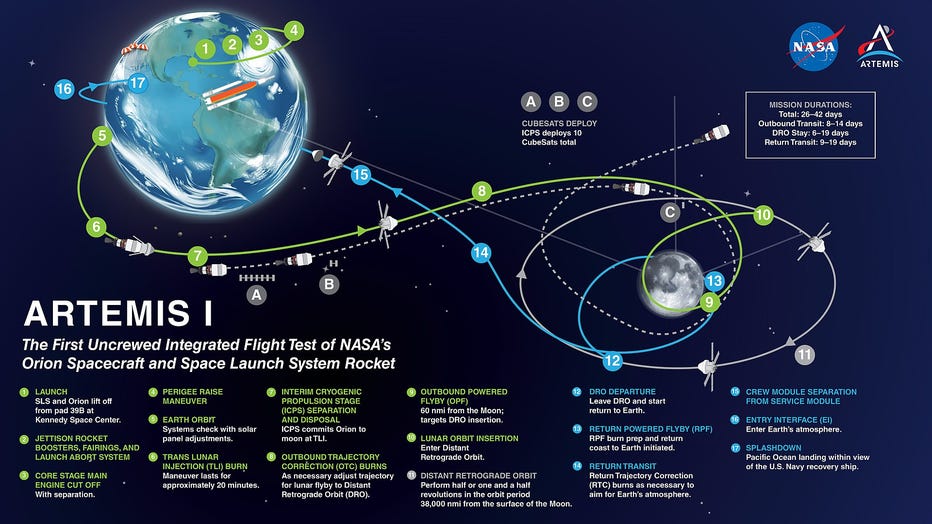Artemis I mission: NASA to try second moon rocket launch on Saturday, Sept. 3

Artemis I launch moved to Saturday
NASA will try again to send the Artemis I moon rocket into orbit on Saturday after having to scrub a launch attempt on Monday.
LAKE MARY, Fla. - NASA will try again to send the Space Launch System (SLS) rocket and Orion spacecraft into orbit this weekend after technical issues scrubbed Monday’s attempt. The unmanned Artemis I mission is supposed to be a test flight that will return a spacecraft to the moon's orbit after nearly five decades. The launch precedes Artemis II which will be the first crewed test flight to the moon since Apollo 17 in 1972.
Artemis 1 mission managers announced Tuesday that teams are preparing for the second attempt during a 120-minute window opening at 2:17 p.m. on Saturday, Sept. 3.
NASA Artemis mission manager Mike Sarafin said the decision to move forward happened after reviewing the data following the first Artemis 1 launch attempt on Monday that ended in a scrub. Several technical issues popped up while the SLS was being fueled with 700,000 gallons of cryogenic propellant during Monday's countdown.
After a lightning delay, Launch Director Charlie Blackwell-Thompson gave the "go" to begin fueling the SLS on Monday around 1 a.m. Several potential hydrogen leak issues cropped up during the countdown, but ultimately it was the engine temperature that caused the launch director to scrub the liftoff attempt just after 8:30 a.m. Monday.
"What held us up on our attempt on Monday was the fact that we got a late start due to the weather, and so then our tanking timeline pushed into the window, and then we had a technical problem that to resolve that technical problem required more time than what we had in the window remaining," Blackwell-Thompson said.
The technical issue was not the engine hardware, but the bleed system used to get the rocket engine to a very cold temperature. Engines 1, 2 and 4 were close to temperature, but engine 3 was not. This could be caused by a hydrogen leak or a sensor error, NASA managers said Tuesday. The SLS is fueled with liquid hydrogen, a tiny molecule that also created problems for the space shuttle program.
SLS program manager John Honeycutt said the four RS-25 engines on the SLS core stage should be chilled to minus 420 degrees Fahrenheit and engine 3 was about 30 to 40 degrees from hitting that mark. Engines 1, 2 and 4 were at minutes 410, so technically, none of the engines were at temperature.

Artemis I mission [Credit: NASA]
The test flight will last 42 days and send Orion on an extended moon orbit, before splashing down in the Pacific Ocean off the coast of California on Oct. 10, at a return speed of up to 25,000 mph.
The mission is to complete a lunar orbit, traveling a distance of about 280,000 miles from Earth around the moon. After launching from Kennedy Space Center, the SLS will send the Orion spacecraft on a trajectory to orbit the moon.
"Once they launch that vehicle and unleash the 8.8 million pounds of thrust. We'll start our journey," explained Judd Frieling, Artemis 1 ascent & entry flight director. After the SLS clears the KSC launch tower, the rocket will roll in a direction to bring Orion to a "heads down position," according to Frieling.
MORE ARTEMIS I HEADLINES:
How SLS, NASA's new mega moon rocket, compares to Apollo-era Saturn V
Artemis l: Mission overview of NASA's historic moon rocket launch
What does the Artemis symbol mean?
The vehicle will experience maximum dynamic pressure one minute into the flight, the point when the most physical strain is on the rocket.
SLS’s final job will be when the upper stage completes the translunar injection orbit maneuver around 1 hour and 20 minutes into the flight. The 18-minute engine burn will send Orion on its way to the moon.
On the way to the moon, Orion will deploy a handful of CubeSats, said Rick LaBrode, lead Artemis I flight director. The spacecraft will complete a series of trajectory correction burns on the first day in orbit. One of those burns will ensure the spacecraft moves ahead of the rocket's upper stage and the CubeSats eliminating any potential threat.
NASA officials said many hurdles were cleared before and during the two-hour launch window. In the end, it was a hydrogen leak that needed a closer look. The issue was one that the Artemis rocket didn’t experience during any of the four wet dress rehearsals. Experts say the issue is not devastating.

